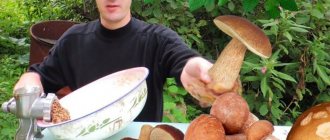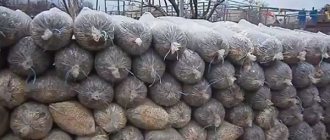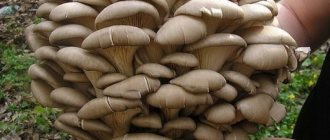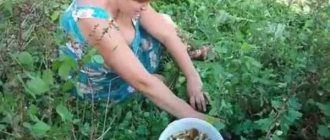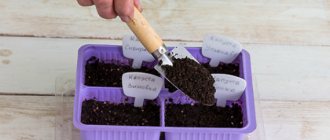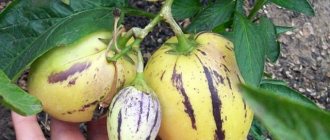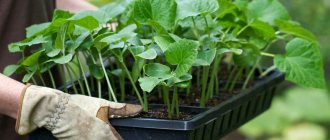Growing porcini mushrooms in a personal plot is not as adventurous a task as it might seem at first glance. The key to success is to recreate an environment similar to natural conditions.
In forests, boletus mushrooms prefer to grow under deciduous or coniferous trees, so owners of dachas with oak, birch, pine or spruce can count on a good harvest. However, if you make an effort and follow the advice of experts, porcini mushrooms can be grown even in a greenhouse or basement.
Basic techniques for growing mushrooms
There are several ways, which are divided primarily by location. Outdoors – an extensive technique, indoors – intensive.
In any case, a person must work hard to create the most favorable conditions for plants. Therefore, first of all, you need to choose a method of growing that is convenient for you, purchase everything you need and equip a place for planting mushrooms.
In addition, there are two known most productive approaches to growing mushrooms, including boletus mushrooms.
Canadian technology for growing mushrooms
The technology is considered universal and low-cost, which ultimately does not lead to large financial losses.
- It is often used in the absence of experience, as an experiment, or simply for growing mushrooms in small quantities.
- All you need is a small box, a properly selected nutritional concentrate and a convenient place in the house.
- No harmful chemicals are used, and the final product is completely safe for health.
Dutch technology for growing mushrooms
This technology requires significant investment and special equipment, which is justified by an intensive approach.
- It is required to properly equip the room, with strict adherence to all standards for lighting, humidity, and temperature.
- With this approach, you can expect large and multiple harvests within a given season.
- Most often, in Dutch technology, mycelium is used when planting. You should choose planting material meticulously.
The presence of an ammonia smell indicates that the product is overdried, which means that mushrooms will not grow.
Sales market
To supply your products to retail outlets and conclude the corresponding agreement, you must collect the following documentation:
- conclusion of Rospotrebnadzor after laboratory tests confirming that the mushrooms do not contain harmful substances and are suitable for consumption;
- product quality certificate issued by Rosstandart;
- regulatory documents for the storage and transportation of mushrooms and products made from them.
Scientists have discovered substances in porcini mushrooms that prevent the appearance of tumors.
In ancient times, an extract from them was used for frostbite. Fresh porcini mushrooms can be sold in the following areas:
- restaurants, cafes and canteens;
- organize delivery to the market, shops and supermarkets;
- enter into a purchase and sale agreement with the processing plant.
Porcini mushrooms can be sold not only fresh, but also dried or canned. The resulting harvest will never be lost.
We recommend that you familiarize yourself with the terms and methods of storing porcini mushrooms.
Effective growing techniques
There are several ways. Everyone decides for themselves how to grow porcini mushrooms in the country, which option is most suitable - some have a large plot, some can allocate a room in the house, and others are able to build a large greenhouse or rent a hangar. It is worth making a brief overview of the basic techniques.
Near the house
The easiest way to grow porcini mushrooms is in your personal plot. To do this, it is necessary to have trees of certain species (birch, oak, pine, spruce) at least five years old. There should be no berry or ornamental bushes or fruit trees near them.
You should purchase mycelium from a specialty store. You can also use mushrooms collected in the forest, or part of the mycelium - a layer of soil the size of a sheet of paper.
- In the spring, you should fertilize the soil under those trees that are indicated in the instructions for the mycelium. Or under trees similar to those from under which the planting material was taken. Mushrooms that previously grew under birch trees will not produce a harvest under oak or pine trees. A circle with a diameter of up to 1.5 meters around the trunk should be processed.
- In the prepared soil, depressions are made (in a checkerboard pattern, at intervals of 30 cm), and pieces of mycelium, or mycelium, are laid out in them. After this, everything is covered with turf, watered abundantly, and straw mulch is laid on top. Humidity should be maintained by constant spraying.
- Caps from ripe mushrooms are laid out for 5-7 days, after which they are removed and the litter is spilled with water. You can also use dried caps by breaking them and placing the pieces in the prepared recesses. The litter should be compacted and watered.
In addition, you can make an infusion of mushrooms (with sugar or alcohol, soak for a day), which is then poured onto the prepared soil.
If favorable conditions for growing porcini mushrooms are maintained, there is a high probability of obtaining a harvest next year.
Greenhouse cultivation
For successful cultivation of mushrooms in a greenhouse, the most important rule is to create conditions as close as possible to natural ones. And this is high humidity, the required temperature for ripening is about twenty degrees Celsius.
Diffused light (special lamps for plants are perfect), good ventilation or natural ventilation, and mandatory anti-mold treatment.
Mycelium intended for indoor spaces should be added to the soil, and the greenhouse itself should not be located on the sunny side.
In a basement
The method of growing mushrooms in the basement of your own house (in a barn, a separate room, in the attic) is practically no different from greenhouse cultivation, only for the process you will have to purchase some equipment: Racks for growing mycelium, refrigeration chambers for storing crops.
Particular attention will need to be paid to ventilation equipment: It is quite possible that in order to maintain the required temperature conditions you will have to purchase water heating boilers or an air conditioning unit.
Useful tips
There are usually no difficulties when growing boletus mushrooms, but sometimes, due to inexperience, novice mushroom growers make mistakes.
Useful tips from successful farmers:
- The tree under which the mycelium is dug and the one where it is planned to be grown must be of the same species.
- Be sure to learn the difference between a real boletus mushroom and an inedible gall mushroom.
- The specimen selected for propagation by spores should be immediately soaked after collection: the spores and pulp quickly decompose.
- When watering the beds, do not overdo it. The soil should always be moist to a depth of 15 cm, but not wet. 40 liters of water is enough for one tree.
- When soaking the pulp for propagation, you can use alcohol instead of sugar. For 10 liters of liquid, 4 tbsp is enough. l. alcohol.
- Sowing is carried out no later than September, otherwise in winter the mycelium will die before it has time to take root.
- The place should be lit, and the crown of the tree will provide light shade.
- Planting is carried out on cool, cloudy days.
When choosing planting material in the forest, you need to be able to distinguish a false specimen from a real one.
The gall mushroom differs from the boletus mushroom in the pink color of the tubular layer; in the real species it is yellow or white; the blende darkens when cut, unlike the edible fruit. Thus, growing and enjoying your own harvest of porcini mushrooms is not difficult. The main thing is to follow the rules for planting and collecting material.
Rules for selecting and preparing mycelium
The easiest way is to purchase ready-made mushroom mycelium in the store; it costs no more than flower seeds.
If this is not possible, then you can grow mycelium yourself, especially since there are already well-proven practices. For any existing method, you need to collect about a dozen overripe mushrooms (preferably with large caps), and prepare the seedlings using one of the three most common methods.
With yeast
For growing seed for apartments, greenhouses or basements, the method using yeast is considered optimal.
Three caps are washed, ground in a meat grinder and filled with solution:
- 50 grams of yeast are diluted in four liters of water (preferably rain or well).
- The resulting mixture is stored for two weeks in a warm and dark place.
- After this time, the mixture is mixed well, two hundred milliliters are poured and diluted in two liters of water.
Without yeast
For planting in open ground, another method is more acceptable.
- The procedure is similar to that described above, but yeast is not needed here: the crushed caps are poured with water, and after two weeks the mixture is filtered through cheesecloth.
- The cake is laid out around a tree trunk (it should be birch if the mushrooms were collected under birches, pine if under pine trees, etc.), and the liquid is left to settle for another three days and then spilled over the soil with planting material.
With potassium permanganate
If you plan to plant in a greenhouse or open ground, you can use the following recipe for growing porcini mushroom mycelium:
- Dilute potassium permanganate in a bucket of water until pale pink, add fifteen pieces of sugar.
- Next, pour the crushed mushroom caps with the resulting solution and leave for twelve hours.
- After this time, the mixture should be filtered and the resulting cake used for planting.
Reproduction by spores
When there is already a harvest, you can propagate the crop. They do this as follows:
- One large fruit should be left in the garden so that it becomes overripe.
- Then its cap, which contains the spores, is crushed, removing the skin.
- The mass is placed in a container (a 1 liter jar is possible), 5 g of sugar, 20 g of yeast are added and clean, preferably spring water is added.
- The mixture should stand for 2 weeks in a warm place.
- After this, 150 ml of mushroom infusion is brought to a volume of 10 liters with clean water and the selected area of soil is spilled.
- Then regular watering is carried out so that the moisture, seeping deep, pulls the spore material with it.
Equipment selection
Mushrooms are grown indoors at home, so special requirements apply only to shelving - they must be metal or plastic.
The use of wooden structures is unacceptable, since mold actively reproduces on them in conditions of high humidity. The rest of the equipment can be anything; its function is to maintain the necessary climatic conditions.
- Drip systems are mainly used for irrigation, and injection and exhaust fans with filters are used for ventilation.
- To maintain the required climate, various heating devices and air conditioners are used.
It is advisable to install ultrasonic sprayers or automatic fog generators, and fluorescent lamps are quite suitable as lighting; better, of course, are the so-called phytolamps, which have a certain color temperature favorable for plants.
Of course, you need refrigerators - the collected mushrooms need to be stored somewhere.
Breeding boletus in the basement
In basements or garages, boxes filled with nutritious soil and installed on multi-tiered racks can be used for planting boletus mushrooms.
Experienced mushroom growers recommend adding buckwheat or sunflower husks, hay, deciduous or pine sawdust, and chopped corn cobs to the soil mixture.
The period of formation of the mycelium takes place in complete darkness, but with the appearance of the first small mushrooms you will have to take care of additional lighting.
It can be either natural or artificial: fluorescent lamps or more economical LED lamps are best suited. The total daylight hours should be 5 hours or more.
A few words about the harvest
The following rules should be observed: do not cut the mushroom with a knife, but carefully twist it, trying not to damage the mycelium; the depressions left after harvesting should be filled with soil.
If you follow these simple rules, you can quite realistically collect up to twenty kilograms of mushrooms from one square meter.
In Russia, only a few are engaged in growing boletus mushrooms, since at the initial stage this type of activity requires serious financial investments. To justify your investment and start making a profit, you need to be patient.
Experienced entrepreneurs advise obtaining all the necessary documents, and only after that purchasing equipment, and starting with small areas.
Profitability
Growing boletus mushrooms can be quite a profitable business . Porcini mushrooms are most in demand among the population due to their excellent taste. The prices for this product are quite high. For 1 kg of porcini mushrooms they give about 1 thousand rubles.
During Lent and on holidays, the cost of this product increases. Therefore, the profitability is about 40%. This business pays off quickly - within 1-2 years. In addition, you can start with small volumes, drawing up a business plan and calculating expenses, and then gradually increase production.
Did you know? In 1961, Moscow radio reported the discovery of a boletus weighing more than 10 kg and a cap with a diameter of 58 cm.
Porcini mushroom is a desirable product at the table. Due to the great demand for boletus mushrooms, the business of growing them will always flourish. The main thing is to use high-quality planting material and create all conditions for growing.
Photo of growing porcini mushrooms
The necessary conditions
Basic requirements for growing outdoors:
- A tree (birch, oak, pine or spruce) should be located nearby, since during symbiosis with it the fungus receives organic substances.
- It is advisable to have other mushrooms nearby.
- The soil should be sandy loam, loamy and at the same time drained.
- Litter in the form of moss and lichens is desirable.
- Good humidity (at least 70 percent).
- Temperatures range from 8 to 18 degrees.
When the site is ready, you can start planting the mushroom. This is best done from late summer to early autumn.
Basic requirements for growing indoors:
- Heating system to maintain the temperature around 18 degrees.
- Hoods for ventilation.
- Shelving for efficient space filling.
- Lamps with diffused light for good lighting.
- Containers for growing. These can be plastic pots or 6-liter bottles and other similar utensils.
- Treat the room with a sulfate solution and cover the walls and ceiling with a mixture of lime and copper sulfate before planting the mycelium. You can additionally use a smoke bomb.
Care
The first shoots of boletus mushrooms can be noticed after just one week, and it is then that it is advisable to reduce the air temperature to 16 degrees. The soil needs to be watered daily with a spray bottle.
All necessary conditions and requirements for mushroom growth are maintained throughout the entire period. In order for the harvest to delight with ever larger shoots, you can additionally use ammonium nitrate in a ratio of one to five.
